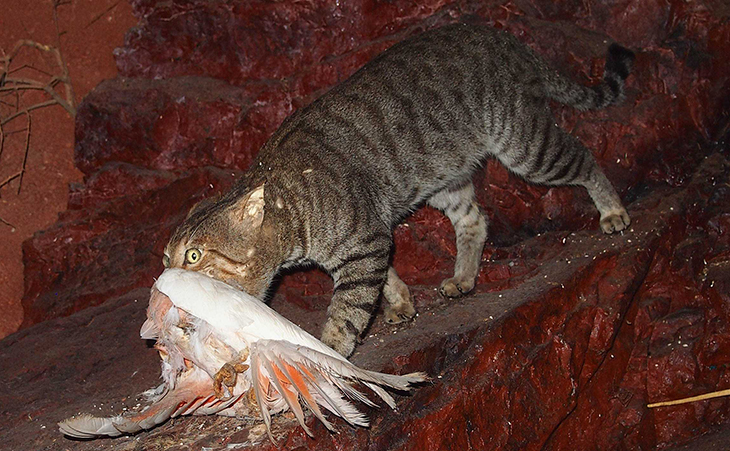New Tech Needed For Fight Against Feral Felines
(Inside Science) -- Australia is gathering an oddball collection of deadly technologies, including poison sausages, goo-squirting traps, and toxin capsules implanted in animals. The list may sound like the something out of a James Bond movie, but the country is employing these very real tools to fight not spies but its destructive and growing population of feral cats.
Last month, the environment minister set a goal of culling two million feral cats by 2020. Australia’s native fauna evolved without feline predators, so cats have had easy meals for decades --- one expert estimated that each feral cat kills an average of five native animals per night on the continent.
To do some damage to the tough kitties, the government has some big plans. It is dropping a poison sausage bait called Eradicat -- made of kangaroo meat, chicken fat and cat-attracting flavor enhancers -- on 1.3 million hectares in Western Australia. The soft sausage is filled with a hard pellet containing a toxic chemical derived from an Australian plant. Since cats tend to shear their food and swallow portions whole, they're more likely to ingest the pellet than other wildlife that spend more time chewing.
"Only introduced predators will be affected by the toxin, as most native species have a high tolerance to the poison," said Katherine Moseby, a researcher at the University of Adelaide and Arid Recovery, a conservation research initiative.
Moseby said that while the effort is a good first try, many cats fail to find the sausages or other poison bait before the deadly treats break down and are no longer toxic. Cats eat only when they're hungry and are typically attracted to a prey animal based on its movement. Also, other animals sometimes find the bait first, such as the western quoll (a small nocturnal marsupial).
To improve cat management efforts, Moseby's colleague and husband John Read helped to create a grooming trap that squirts out poisonous paste onto the fur of cats when activated by motion. Since cats are compulsory groomers, they will immediately lick themselves to clean off the sticky goo.
In one study, published in the International Journal of Pest Management last year, researchers tested a proof-of-concept grooming trap. A cat that triggers the trap is squirted with a gel containing para-aminopropiophenone (also known as PAPP) -- a toxin that targets the haemoglobin in red blood cells that carries oxygen to the heart muscles and brain.
In the test, 14 of 16 feral cats tracked by the researchers in the wild showed symptoms of low oxygen supply. Eight of the cats were dead by the following morning without exhibiting signs of distress. The trap has a range of more than 13 feet.
Another method of cat control is to target specific, prolific hunters in the feral cat community. Moseby and Read, along with colleagues, created a predator profile and analyzed individual cats. They concluded that large male cats were often the killers of native quolls– while smaller cats, which tend to be females or low-ranking males, generally eat birds and snakes. The researchers are working on a kind of fatal Trojan horse by injecting capsules under quolls' skin. The capsules would remain stable under the skin but break down in the gut of cat when ingested, explained Moseby. "Cats do not chew their food thoroughly and consume almost all of the prey they eat, so the capsule is likely to be ingested during prey consumption," she said.
The method may prove most useful when animals -- like the quoll -- are being reintroduced into their former range. It should prevent repeat offenders, said Moseby.
In urban environments, U.S. city officials are taking a more gentle approach to managing feral cat populations. Kathleen O'Malley, a cat caretaker with the NYC Feral Cat Initiative says that TNR – also known as trap, neuter, return – is a much better way of reducing feral cat numbers over time. These programs are more labor-intensive and expensive, as the cats have to be carefully trapped and surgically sterilized.
Chemicals can be injected to reduce a male cat’s abilities to breed, such as Zeuterin, but O'Malley warned that they don't reduce the behaviors people dislike in stray cats. "TNR stops the behaviors associated with mating, like spraying to mark territory with hormones that make urine offensively smelly," she said. "It also curtails their roaming behavior because they're not going out looking for mates, so the cats have smaller territory."
O'Malley mentioned that some research shows that reducing cat populations in Australia actually boosts the populations of another invasive species, rats. Efforts directed at cats also ignore other, potentially larger threats to Australia’s wildlife, such as the non-native fox. Finally, she said, the citizens may not have the guts for a long war with felines. "My view on the Australian policy is it's not going to work unless they are dedicated to years of bloodshed -- and the public is going to lose their stomach for it."
Moseby pointed out that most feral cats in Australia live independently of humans, so neutering semi-wild cats will not make a huge difference to the wild population -- it wouldn't be feasible to neuter enough cats to make a dent in their damaging activities. Neutering also leaves cats in the environment to kill native wildlife.

